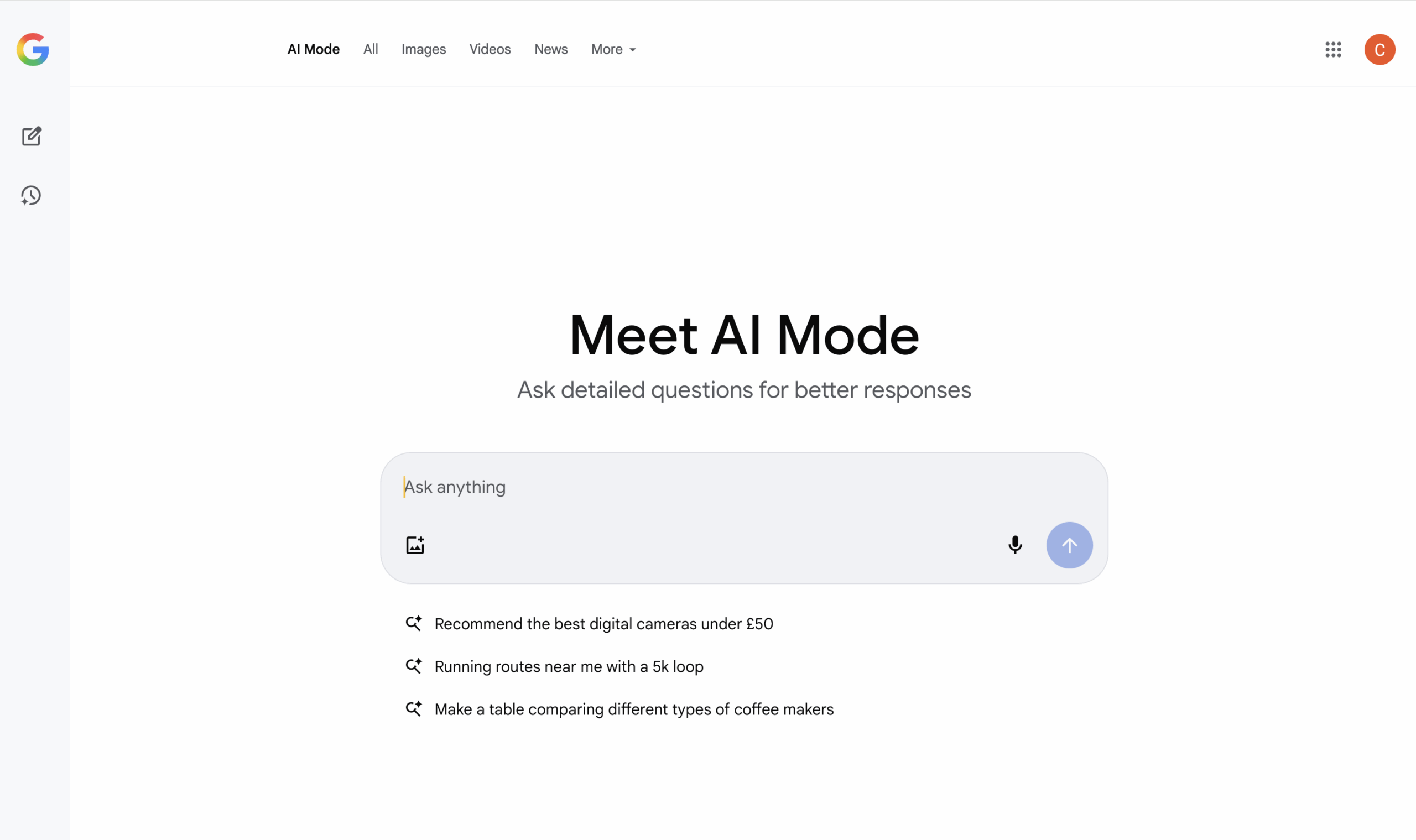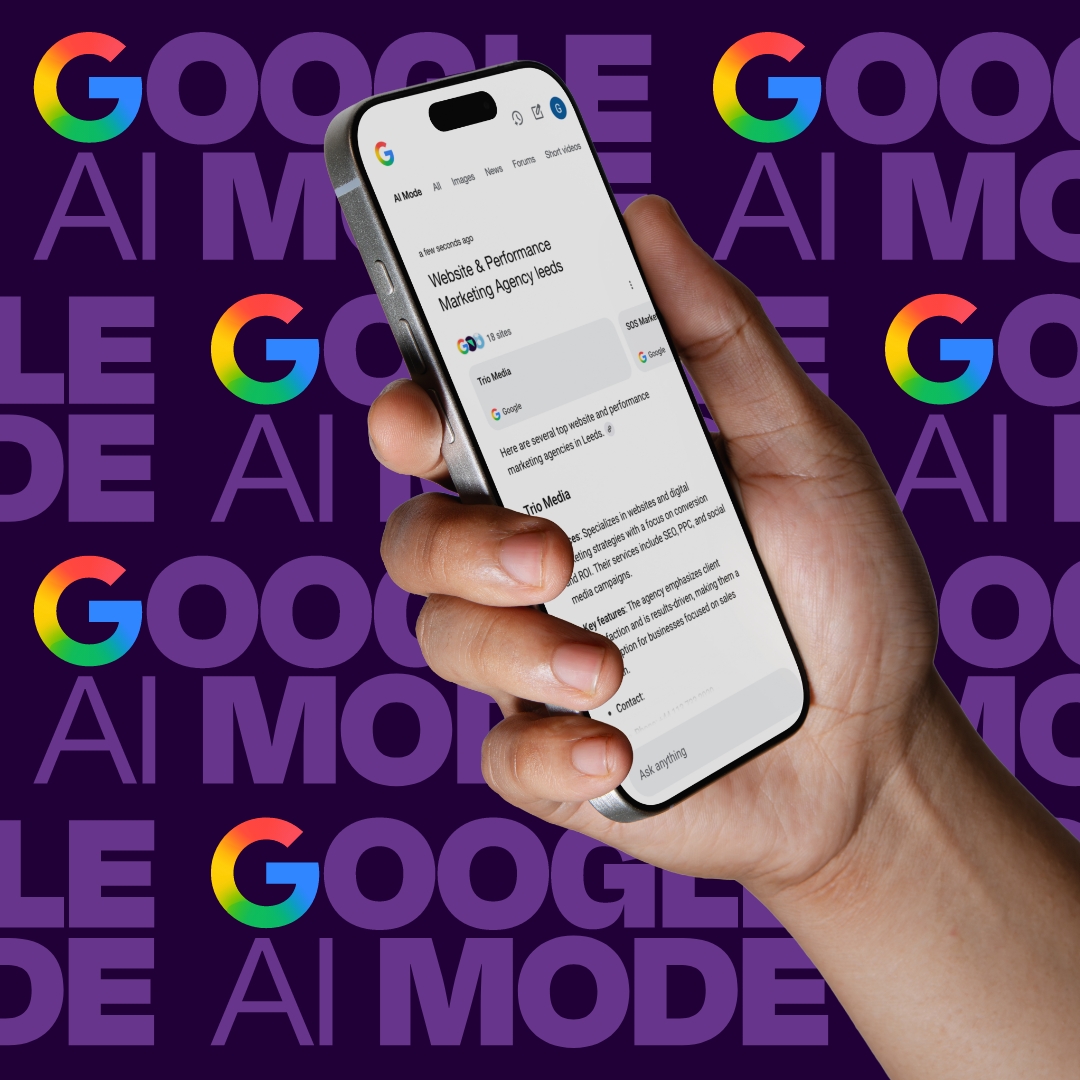Introducing AI Mode, Google’s latest AI search tool that aims to take search and discovery to the next level.
In this post, we will explore how it works, how to access it, how it compares with its little brother, Google’s AI Overview, and how it differs from LLMs like ChatGPT and their approach to search.
Jump to each section:
TL;DR – SEO is not dying – AI mode is changing it?
What is Google’s AI Mode?
How to access AI Mode
How AI Mode differs from Google Search
Google’s AI Overview vs AI Mode
How AI Mode differs from ChatGPT
How AI Mode will affect the future of SEO
How Google’s AI Mode decides what to show
Breaking down SEO acronyms
TL;DR – SEO is not dying – AI mode is changing it?
People are worried that SEO is dying and these newer, answer engines will take over. It’s actually far from it. By learning about AI-driven answer engines and how they work, we have a whole new world to explore as marketers and adopt for brand discovery.
AI Mode is Google’s latest development following the introduction of AI Overview. AI Mode is a more powerful answer engine, similar to ChatGPT; however, it is not as advanced in its features. It uses Google’s search engine to draw contextual, conversational-based answers to users’ queries.
What is Google’s AI Mode?
AI Mode is Google’s newest AI search feature designed to help answer users’ queries in an interactive, conversational style. Instead of showing you a list of links, AI Mode engages with your question directly and provides summarised, context-rich responses.
How to access AI Mode
There are several ways to access and use AI Mode:
- Through search: Type your query as usual in Google’s search bar and press Enter. Alongside the standard tabs like All, Images or News, you will see an “AI Mode” option in the menu under the input box. Click “AI Mode” and wait for the results to load.
- Through AI Overview results: On the AI Overview SERP section, you’ll see a button labelled “Dive deeper with AI Mode”. Clicking this takes you directly into a more conversational search experience.
- Google Homepage: You can also access AI Mode straight from Google’s homepage by pressing the ‘AI Mode’ button inside the search bar.
- Direct link: Alternatively, you can access it directly through the link google.com/aimode. In this case, you will start using the feature without performing a standard search first.
Can’t find a way to access it? AI Mode isn’t available everywhere yet. Currently, it is available only in the US, UK and India. The only way to try AI Mode outside these regions would be to use a VPN and set it to one of the eligible countries.

How AI Mode differs from Google Search
Traditional Google Search presents a ranked list of web pages relevant to a user’s query on the SERP (Search Engine Results Page). Users typically rely on page titles, meta descriptions, and SERP features/snippets to decide which result best matches their needs, though enhanced features like featured snippets and knowledge panels increasingly provide direct answers.
AI Mode goes further by giving a richer and more detailed response. Unlike traditional search engines, which simply trigger a results page with a query, AI Mode launches a more dynamic process. This involves:
- Searching various subtopics for the search query
- Scanning multiple sources online
- Extracting key information, with linked resources to explore further
- Stitching everything together to form a single response
Google’s AI Overview vs AI Mode
Although AI Overview and AI Mode may seem similar, they are distinct in terms of their functionality and intended use.
Google’s AI Overview
AI Overview delivers a quick, concise summary of search results by extracting key points from relevant sources. It is designed for speed and simplicity, helping users get an at-a-glance answer without clicking through multiple links. Google generally shows AI Overview when it is confident the summary will be accurate and reliable. If the system cannot confidently summarise a query, AI Overview may not appear. While AI Overview aims to provide accurate summaries, it may occasionally oversimplify or misinterpret information, so users should verify critical details from the original sources.
Learn more about AI Overview:
Google’s AI Mode
AI Mode is designed for more in-depth reasoning and comprehensive results. It uses a technique called query fan-out, which breaks a user’s question into smaller subtopics and searches them in parallel. This process enables richer synthesis, stronger reasoning and context-rich answers.
AI Mode runs a custom version of Gemini 2.5 with a massive 1 million+ token context window (accurate at the date this article is published). This means that AI Mode can answer follow-up questions and maintain the conversation, a feature more typical of other LLMs. The context also scales at scale to enable it to remember users’ preferences across different threads.
Beyond text responses, AI Mode also supports advanced features, such as file uploads, voice recognition, and live search using videos and images taken with a phone. These features push it far beyond the capabilities of AI Overview.
How AI Mode differs from ChatGPT
While Google’s Gemini powers AI Mode and works similarly to ChatGPT, there are a few key differences that set them apart.
Data sources
AI Mode has direct access to Google’s search index and knowledge graph, allowing it to actively retrieve and process information from real-time web content.
ChatGPT, on the other hand, can access web content through specialised tools, but by default, it relies on its pre-trained knowledge base, which has a cutoff date, i.e. the point at which its training data ends. This is why, since ChatGPT gained popularity, we have seen versions GPT-3, GPT-4 and now GPT-5 become available.
Transparency and citation
AI Mode sources its answer directly from web content, it automatically provides links that allow users to verify the information.
ChatGPT can also provide citations when prompted, but it is more prone to hallucinations, producing plausible yet incorrect answers or even fabricated sources.
Use case differences
When comparing the two, Google’s AI Mode is made for search when you need factual, up-to-date information, with the ability to easily verify sources.
ChatGPT’s search function is one aspect of a broader range of capabilities, which include deep research, creative ideation, writing assistance, coding and interactive learning.
How AI Mode will affect the future of SEO
In our latest ebook, we cover the importance of optimising for zero-click searches, which now account for over 60% of all online searches.
We expect this trend to continue rising with AI-driven answer engines becoming the norm, replacing traditional search and find formats. As such, content now needs to be structured not only to be found, but also to be quoted or summarised directly by AI.
There are also several other components at play. Google’s AI draws on a wide range of information when deciding what content to display. Some of the most essential sources include:
On and off-page signals
- Official website: Google looks to a company’s own website for accurate details such as services, pricing, FAQs and opening hours. Well-structured sites with clear headings and high-quality content are more likely to be trusted as sources.
- Structured data (schema): Adding schema markup helps Google interpret a page’s purpose. For example, the LocalBusiness or Product schema makes it easier for the AI to extract specific details, such as reviews, pricing or availability.
- Knowledge Graph: Google maintains a massive database of entities (people, places, and things) and their relationships. It draws from sources such as Wikipedia, Google Maps and trusted data providers.
- Google Business Profile: For local searches, Google increasingly relies on its own Business Profiles to provide users with accurate and up-to-date information, including addresses, hours, services, and photos. By surfacing these details directly in search results, Google can keep users within its ecosystem, reducing the need to click through to external sites. Optimising your Business Profile is therefore essential for visibility, especially for “near me” queries.
- Review platforms: While Google does consider third-party review platforms like Trustpilot and TripAdvisor, it increasingly prioritises Google Reviews. Reviews within the Google ecosystem directly influence AI and search recommendations, shaping public perception and trust. Ensuring a steady flow of authentic reviews on your Google Business Profile helps the AI evaluate and promote your business effectively.
- Social media: Platforms such as Facebook or TikTok can also surface in results, particularly for community-driven or trending topics.
- User-generated content: Reviews and photos uploaded directly to a business’s Google Business Profile are factored into how the AI evaluates and recommends businesses.
Authority and trustworthiness
- E-E-A-T: Google favours content that demonstrates credibility and follows its E-E-A-T guidelines. This means:
- Experience: Content created by someone with hands-on knowledge or practical experience on the topic.
- Expertise: Referencing reputable third-party sources (news outlets, industry publications).
- Authoritativeness: Including author bios and credentials; being cited by other reputable sites.
- Trustworthiness: Use HTTPS; maintain consistent business details (name, address, phone); provide clear contact info and policies; display reviews and testimonials.
- Topical authority: Rather than relying on one strong page, Google tends to reward businesses that consistently produce high-quality content around a specific subject area.
- User feedback: Google also refines its systems based on how people interact with results, for example, what they click, how long they stay, and which summaries prove most useful.
How Google’s AI Mode decides what to show
For any given search, Google’s AI Mode follows a structured process:
- Understand the query: The AI interprets the user’s intent to determine the type of answer they’re looking for.
- Gather content: It pulls relevant material from a variety of trusted sources and, importantly, not just the top-ranked result.
- Synthesise information: Using its language models, it compiles the findings into a clear, conversational summary.
- Provide citations: References are included so users can verify the original sources themselves.
For anyone claiming SEO is dead, they couldn’t be more mistaken. People working in SEO now need to broaden their skills further as they optimise not only for search engines, but for answer engines and LLMs too, factoring in all the components above.
Breaking down SEO acronyms
SEO experts are also having a rough time at the moment, keeping up with all the new acronyms and naming conventions, as people rush to rename a historical practice.
Below, we’ve broken down the meaning behind all of the latest acronyms so that you can make up your own mind on what to call it.
- GEO (Generative Engine Optimisation): Focuses on optimising content to be found or cited in AI-generated responses
- AEO (Answer Engine Optimisation): Focuses on providing direct, concise answers to AI-powered engines, with a particular focus on Q&A style formats.
- AIO (Artificial Intelligence Optimisation): Focuses on making content clear and well-structured so AI tools can read, find, and use it effectively.
- LLMO (Large Language Model Optimisation): Very similar to AIO, it focuses on ensuring that LLMs can easily find, understand, and incorporate your content in their responses.
- SXO (Search Experience Optimisation): Focuses on improving user experience after someone lands on your site, for example, with page speed, mobile usability, navigation, and engagement.
Call it what you want to call it – if you work in SEO and already follow best practices like we do, you’ll recognise that your work naturally combines all of the approaches above.
Still confused about AI and SEO?
We’re organising an event in Leeds about AI in search. Send our team a message to be added to the list and receive an exclusive invitation first!



